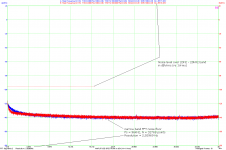It is not. OPA827 and ADA4627 are both much better (my private measurements).
erm... i've not heard of those dual opamps....
the opa1642 is a much better dual opamp than OPA827/ADA4627 🙄
I answered the specific question, rather than 'answering' by inserting my preference for something else
if we were asked about singles, I would also place those 2 above 1642, or 1641 for that matter... but lme49990 would also get a look in. it really depends on the specific application, but 1642 is superior to OPA2134 without a doubt. jfet input duals are not thick on the ground.
Last edited:
..........I answered the specific question, rather than 'answering' by inserting my preference for something else.............
Yes duals 🙂
I did some real world tests a few days ago on what I had available, all running on around -/+15 volts
LM4562 managed -/+13 volts into 330 ohm, same for the NE5532 falling to -/+ 9 volts into 220 ohm. I was quite impressed tbh. The TLE2072 which I had high hopes for could only manage -/+ 10 volts and -/+ 8 for 330 and 220 ohm loadings.
Just really trying to pull bits of information together really... its easy sometimes to go with the old standards... and that's why I was curious what you folks might use given a free hand.
It is not. OPA827 and ADA4627 are both much better (my private measurements).
Samuel Groner has measured OPA827 and the results were not that impressive compared to OPA627. It was suggested on a TI forum that the initial batch had some issues that are now corrected. Does the OPA827 measure better for you than OPA627 or ADA4627?
Now I'm really, really amused. Scott's choice, the AD8066, has almost 10 times the noise level of the OPA836 ...Regardless low supply voltage, OPA836 has VERY high noise and VERY low quiescent current. No good for audio, would be source of troubles only.
Horses for courses, perhaps ...
Frank
Now I'm really, really amused. Scott's choice, the AD8066, has almost 10 times the noise level of the OPA836 ...
Horses for courses, perhaps ...
Frank
???? 7nV vs. 4.6nV and no current noise, good for volumne controls. As I said at gain of 1 the noise is pretty much a don't care anyway think about the noise of the source. Say a really good .4nV preamp with 40dB of gain, that's 40nV at the output.
OPA836 has very high current noise in comparison to the FET input AD8066. In fact, OPA836 looks to have higher current noise than AD797 and LME49990, but without the super low voltage noise to go along with it. Which to choose depends on whether you are driving it with a low or high source resistance.
Still, I don't see why you would want to use it over any of the standard bipolar input candidates unless it's a portable application.
Still, I don't see why you would want to use it over any of the standard bipolar input candidates unless it's a portable application.
Below 1k the AD8066 noise takes off like a rocket, hitting 10 x the level at 10Hz ...
I am not fussed about noise levels, a little bit of hiss is not a problem for me ... but high frequency distortion really bugs me, that's a big turn off.
So what I like about the OPA836 is that its behaviour is still totally under control at frequencies 10 times higher than the audio band, it's got a huge margin of behavioural stability at its disposal. If an opamp is working at the ragged edge to get the numbers looking good at 20kHz then it's far more likely that the slightest abberation in the implementation will have audible effects ... IMO ...
Frank
I am not fussed about noise levels, a little bit of hiss is not a problem for me ... but high frequency distortion really bugs me, that's a big turn off.
So what I like about the OPA836 is that its behaviour is still totally under control at frequencies 10 times higher than the audio band, it's got a huge margin of behavioural stability at its disposal. If an opamp is working at the ragged edge to get the numbers looking good at 20kHz then it's far more likely that the slightest abberation in the implementation will have audible effects ... IMO ...
Frank
What do you guys think about the LT1358? That is what I use in the Lounge LCR. It is starting to get good reviews. The noisy ones have to be tested for though.
Below 1k the AD8066 noise takes off like a rocket, hitting 10 x the level at 10Hz ...
I am not fussed about noise levels, a little bit of hiss is not a problem for me ... but high frequency distortion really bugs me, that's a big turn off.
So what I like about the OPA836 is that its behaviour is still totally under control at frequencies 10 times higher than the audio band, it's got a huge margin of behavioural stability at its disposal. If an opamp is working at the ragged edge to get the numbers looking good at 20kHz then it's far more likely that the slightest abberation in the implementation will have audible effects ... IMO ...
Frank
Audio frequencies are basicly DC to the 8066 so your argument does not register with me.
I would be happy to take the AD8066, I was merely making the point that noise issues don't register as a major impediment for me when considering opamps. In fact, looking at my directory, I "found" the AD8066 five years ago, when I was doing a lookaround at possibilities for future use ...
I only just ran across the OPA836 that couple of days ago ...
Frank
I only just ran across the OPA836 that couple of days ago ...
Frank
I like the pretty good PSRR and CMRR figures, but don't like the output impedance behaviour nor the distortion starting to deteriorate below 10kHz ...What do you guys think about the LT1358? That is what I use in the Lounge LCR. It is starting to get good reviews. The noisy ones have to be tested for though.
Frank
What do you guys think about the LT1358? That is what I use in the Lounge LCR. It is starting to get good reviews. The noisy ones have to be tested for though.
It will have somewhat excessive current noise for MM, given that large input bias current. For MC, that will be negligible but the voltage noise will be somewhat high compared to the intrinsic thermal noise of the cartridge.
No good. Two channels almost always differ a bit. And crosstalk is not infinite.
The OPA1641 (single), OPA1642 (dual),OPA1644 (quad) datasheet says:
http://www.ti.com/lit/ds/sbos484b/sbos484b.pdf
The dual and quad versions feature completely independent circuitry for lowest crosstalk and freedom from interactions between channels, even when overdriven or overloaded.
When you say other opamps (OPA827 and ADA4627) are 'better', you must mean more than just crosstalk/matching?
http://www.ti.com/lit/ds/symlink/opa827.pdf
http://www.analog.com/static/imported-files/data_sheets/ADA4627-1.pdf
PS I know you've got some sweet, well-documented test data on opamps. This thread is totally dying for some good data! Sy would just die! You're busy with work ... maybe we could get some local diyaudio-er to cut your lawn so you can dig them up ... 😉
Last edited:
Pavel
Thank you for the above explanation. I am one of the guys who are missing a few (truckloads) bits of knowledge.
George
Just to pursue this idea of throwing some open loop gain away a bit further I went and found the original post of Nelsons where he says,
(post #18 here)
http://www.diyaudio.com/forums/solid-state/6558-opamp-inverting-input-sounds-better.html#post67880
Quote "If the circuit has less than 20 dB gain, I toss some away.
With an inverting amp, a resistor from the - input to ground
will do it. If not, then resistance from both + and - to
ground is used.
Works like glue...."
I can't quite follow the last bit for the non inverting configuration.
Godfrey suggested this yesterday,
post #37330,
http://www.diyaudio.com/forums/anal...ch-preamplifier-part-ii-1867.html#post3428278
(post #18 here)
http://www.diyaudio.com/forums/solid-state/6558-opamp-inverting-input-sounds-better.html#post67880
Quote "If the circuit has less than 20 dB gain, I toss some away.
With an inverting amp, a resistor from the - input to ground
will do it. If not, then resistance from both + and - to
ground is used.
Works like glue...."
I can't quite follow the last bit for the non inverting configuration.
Godfrey suggested this yesterday,
You can do it like this. For unity gain, just leave out R3.
post #37330,
http://www.diyaudio.com/forums/anal...ch-preamplifier-part-ii-1867.html#post3428278
I am glad if it helps, George. Graphs without understanding and explanation may be misleading and misused.
This is another example. Noise floor is about -140dBV, measured with 96kHz sampling and 32768 FFT points. Integral noise over 20Hz - 20kHz is about -95dBV (SNR is -95dB referred to 1Vrms). Someone might misinterpret it as SNR = -140dB (referred to 1Vrms).
Attachments
Do you have that in log frequency? (I know, I'm a pain)
I'm not sure of the relevance of crosstalk- after all, phono cartridges rarely have more than 20dB or so and their imaging isn't terribly compromised. Is there data showing audibility of, say, 40dB of crosstalk?
I'm not sure of the relevance of crosstalk- after all, phono cartridges rarely have more than 20dB or so and their imaging isn't terribly compromised. Is there data showing audibility of, say, 40dB of crosstalk?
- Status
- Not open for further replies.
- Home
- Member Areas
- The Lounge
- John Curl's Blowtorch preamplifier part II

